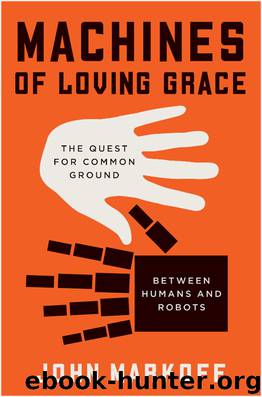Machines of Loving Grace by John Markoff

Author:John Markoff
Language: eng
Format: epub
Publisher: HarperCollinsPublishers
Published: 2015-07-10T16:00:00+00:00
6|COLLABORATION
In a restored brick building in Boston, a humanoid figure turned its head. The robot was no more than an assemblage of plastic, motors, and wires, all topped by a movable flat LCD screen with a cartoon visage of eyes and eyebrows. Yet the distinctive motion elicited a small shock of recognition and empathy from an approaching human. Even in a stack of electronic boxes, sensors, and wires, the human mind has an uncanny ability to recognize the human form.
Meet Baxter, a robot designed to work alongside human workers that was unveiled with some fanfare in the fall of 2012. Baxter is relatively ponderous and not particularly dexterous. Instead of moving around on wheels or legs, it sits in one place on an inflexible fixed stand. Its hands are pincers capable of delicately picking up objects and putting them down. It is capable of little else. Despite its limitations, however, Baxter represents a new chapter in robotics. It is one of the first examples of Andy Rubin’s credo that personal computers are sprouting legs and beginning to move around in the environment. Baxter is the progeny of Rodney Brooks, whose path to building helper robots traces directly from the founders of artificial intelligence.
McCarthy and Minsky went their separate ways in 1962, but the Stanford AI Laboratory where McCarthy settled attracted a ragtag crowd of hackers, a mirror image of the original MIT AI Lab remaining under Minsky’s guidance. In 1969 the two labs were electronically linked via the ARPAnet, a precursor of the modern Internet, thus making it simple for researchers to share information. It was the height of the Vietnam War and artificial intelligence and robotics were heavily funded by the military, but the SAIL ethos was closer to the countercultural style of the San Francisco’s Fillmore Auditorium than it was to the Pentagon on the Potomac.
Hans Moravec, an eccentric young graduate student, was camping in the attic of SAIL, while working on the Stanford Cart, an early four-wheeled mobile robot. A sauna had been installed in the basement, and psychodrama groups shared the lab space in the evenings. Available computer terminals displayed the message “Take me, I’m yours.” “The Prancing Pony”—a fictional wayfarer’s inn in Tolkien’s Lord of the Rings—was a mainframe-connected vending machine selling food suitable for discerning hackers. Visitors were greeted in a small lobby decorated with an ungainly “You Are Here” mural echoing the famous Leo Steinberg New Yorker cover depicting a relativistic view of the most important place in the United States. The SAIL map was based on a simple view of the laboratory and the Stanford campus, but lots of people had added their own perspectives to the map, ranging from placing the visitor at the center of the human brain to placing the laboratory near an obscure star somewhere out on the arm of an average-sized spiral galaxy.
It provided a captivating welcome for Rodney Brooks, another new Stanford graduate student. A math prodigy from Adelaide, Australia, raised by working-class parents, Brooks had grown up far from the can-do hacker culture in the United States.
Download
This site does not store any files on its server. We only index and link to content provided by other sites. Please contact the content providers to delete copyright contents if any and email us, we'll remove relevant links or contents immediately.
| American National Standards Institute (ANSI) Publications | Architecture |
| History | Measurements |
| Patents & Inventions | Research |
Whiskies Galore by Ian Buxton(40332)
Introduction to Aircraft Design (Cambridge Aerospace Series) by John P. Fielding(32338)
Small Unmanned Fixed-wing Aircraft Design by Andrew J. Keane Andras Sobester James P. Scanlan & András Sóbester & James P. Scanlan(32141)
Craft Beer for the Homebrewer by Michael Agnew(17447)
Turbulence by E. J. Noyes(7039)
The Complete Stick Figure Physics Tutorials by Allen Sarah(6638)
Kaplan MCAT General Chemistry Review by Kaplan(6054)
The Thirst by Nesbo Jo(5786)
Bad Blood by John Carreyrou(5769)
Learning SQL by Alan Beaulieu(5412)
Weapons of Math Destruction by Cathy O'Neil(5037)
Man-made Catastrophes and Risk Information Concealment by Dmitry Chernov & Didier Sornette(4736)
iGen by Jean M. Twenge(4702)
Digital Minimalism by Cal Newport;(4542)
Life 3.0: Being Human in the Age of Artificial Intelligence by Tegmark Max(4508)
Audition by Ryu Murakami(4099)
1,001 ASVAB Practice Questions For Dummies by Powers Rod(4039)
Electronic Devices & Circuits by Jacob Millman & Christos C. Halkias(4029)
Pale Blue Dot by Carl Sagan(4001)
